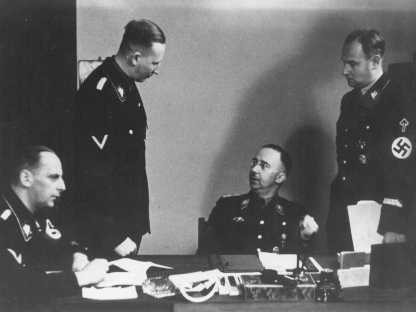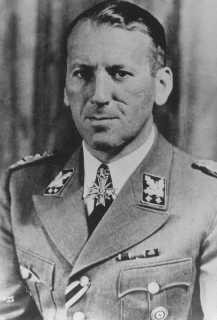Reich Security Main Office (RSHA)
The Reich Security Main Office (RSHA) was a new agency created by Heinrich Himmler in September 1939, shortly after the German invasion of Poland. The office formalized the relationship between the SS intelligence service (SD) and the Security Police, which consisted of the Kripo (Criminal Police) and Gestapo. The RSHA was an ideologically radical and brutal institution responsible for coordinating and perpetrating many aspects of the Holocaust.
Key Facts
-
1
The RSHA was a new agency created in September 1939. It was initially led by Heinrich Himmler’s deputy, Reinhard Heydrich.
-
2
The agency went beyond traditional police organizations in terms of its ideology and conduct.
-
3
The RSHA played a central role in perpetrating the mass murder of Europe’s Jews.

Head of the SS and Chief of the German Police Heinrich Himmler founded the Reich Security Main Office (Reichssicherheitshauptamt, RSHA) on September 27, 1939. This was shortly after the German invasion of Poland on September 1. The timing was no coincidence. The RSHA was intended for war.
The new office formalized the relationship between the SS intelligence service (Sicherheitsdienst, lit. Security Service, often called the SD) and the Security Police (Sicherheitspolizei, SiPo). The Security Police itself was made up of the combined forces of the Kripo (Kriminalpolizei, Criminal Police) and the Gestapo (Geheime Staatspolizei, Secret State Police).
Himmler appointed his deputy Reinhard Heydrich as the leader of the RSHA. This was a logical choice. Heydrich had been in charge of the Security Police since 1936 and the SD since 1931. The creation of the RSHA institutionalized and strengthened his position in Nazi leadership.
The RSHA brought together Nazi ideology (represented by the SD) and administrative and police power (represented by the Security Police). In the hands of the ambitious and radical RSHA leaders, this was a deadly combination.
Goals of the RSHA
Himmler and Heydrich wanted to merge the SS intelligence service (SD) and the Security Police (SiPo) in order to create a shared organizational structure and culture. This was difficult for administrative reasons. It meant combining a trained, professionalized civil service organization (the Security Police) with the SD, a Nazi Party institution staffed by Nazi ideologues. Heydrich hoped that the RSHA would embody both the ideological devotion of the SD and the training and skill of the police. He intended to create an administrative structure that would fully merge the Security Police and SD.
But, Heydrich’s vision never fully came to pass. Instead, for the five and a half years of its existence, the RSHA was an unwieldy, albeit deadly, organization. It was constantly changing. Personnel transfers and overlap in membership confused the relationship between the Security Police and SD. It was, and still sometimes remains, difficult to determine who belonged to what organization.
Staffing the RSHA

The RSHA's leadership corps was made up of highly-educated men mostly in their thirties. They were committed National Socialists. Many were Security Policemen and SD men who had already proven themselves to be violent and ideologically devoted in the prewar era and during the first weeks of the Nazi invasion of Poland in 1939.
Reinhard Heydrich led the RSHA until his death in June 1942. Himmler then temporarily took over its management for approximately 6 months. In January 1943, he appointed a new RSHA leader, Ernst Kaltenbrunner. Kaltenbrunner was an Austrian SS and police leader. He served as leader of the RSHA until the end of World War II.
Organizational Structure
The RSHA’s organizational structure changed several times. But as of March 1941, there were seven RSHA offices named with Roman numerals:
- Office I Personnel
- Office II Organization, Administration, Law
- Office III SD Domestic Surveillance
- Office IV The Gestapo
- Office V The Kripo
- Office VI SD Foreign Intelligence
- Office VII Ideological Research and Evaluation
Each office was divided into subordinate departments and units. These were named by combinations of capital letters, Western Arabic numerals (1, 2, 3, 4…), and sometimes small case letters. For instance, Office IV was made up of five divisions (A-E). These divisions were then further broken down into numbered units.
One of the most notorious offices of the RSHA was Office IV B 4, led by Adolf Eichmann. It was sometimes called Eichmann’s Unit (Eichmannreferat) or the Jewish Unit (Judenreferat). The office coordinated the deportation of Jews from Western, Central, and Southern Europe to ghettos, killing sites, and killing centers.
The RSHA and the “Jewish Question”
The RSHA was deeply involved in the Nazi regime’s attempts to “solve the Jewish Question.” In September 1939, the Nazis had not yet decided on the exact contours of what they eventually called the “Final Solution to the Jewish Question.” The “Final Solution” referred to the planned mass murder of all European Jews. Various organizations within the Nazi regime, including the RSHA, competed to be in charge of setting and developing anti-Jewish policies. No single organization won this right. However, the RSHA ultimately wielded a significant amount of decision-making power over the fate of Europe’s Jews.
The RSHA did not directly control all aspects of the mass murder of Europe’s Jews. But it was very important for planning and organizing Nazi policy. The RSHA coordinated forced emigration policies and organized Europe-wide deportations to ghettos, killing sites, and killing centers. It also developed poison gas killing methods and deployed the Einsatzgruppen. And in January 1942, the RSHA hosted the notorious Wannsee Conference. There, RSHA leaders discussed the "Final Solution" with other top German officials.

